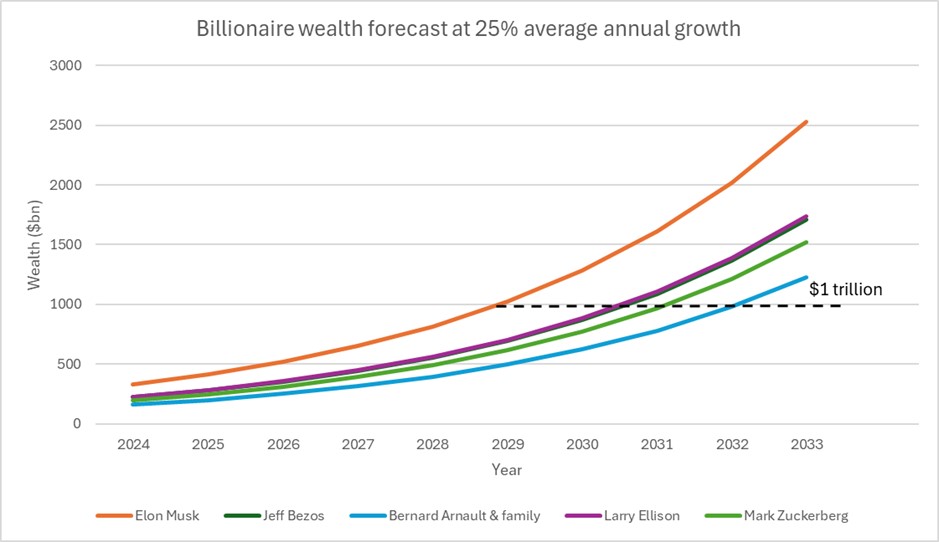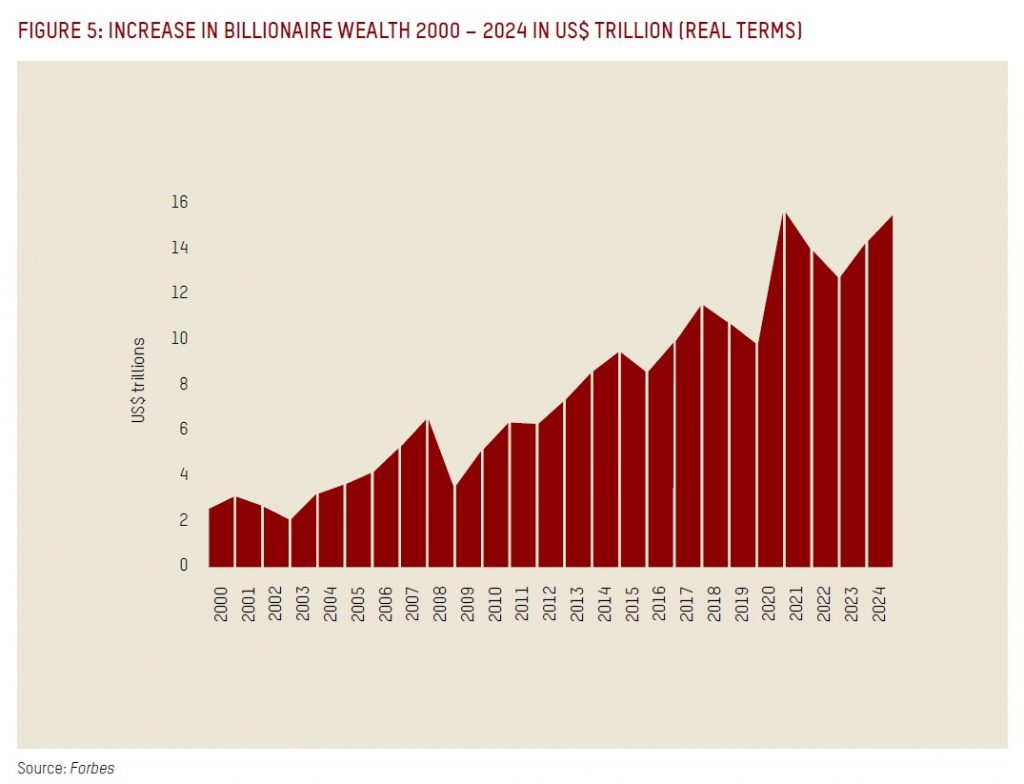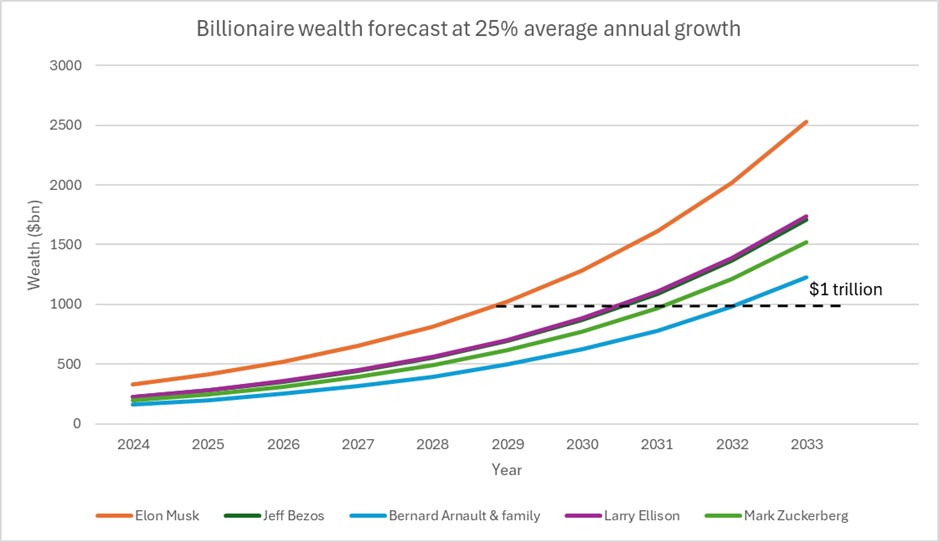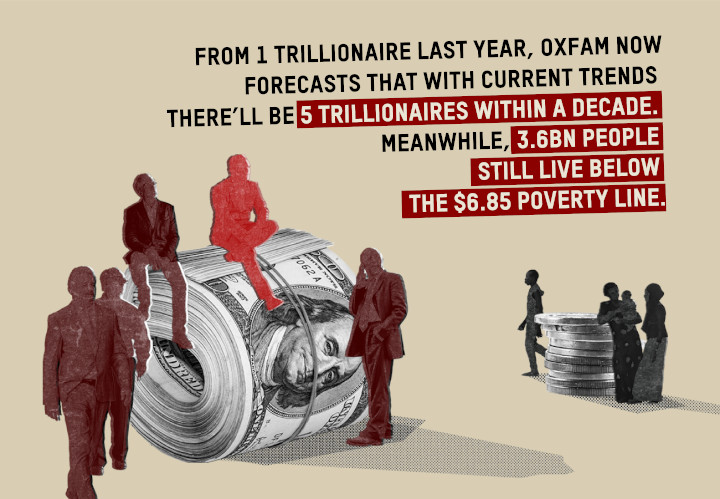
Alex Maitland takes us through the number-crunching behind the headline prediction from this year’s Davos report: that there will be five trillionaires within a decade.
When I was a kid, Who Wants to Be a Millionaire was must-watch Friday night telly in the UK.
It fits into our worldview that hard work, sprinkled with a bit of luck (50/50), and some help from loved ones (phone a friend) and strangers (ask the audience), means anyone could become a millionaire.
As I worked on the stats for our annual inequality report, it became clear that massive billionaire gains in 2024 mean we now forecast five trillionaires within a decade. So I wondered, what would the format of Who Wants to Be a Trillionaire look like?
For a start, much of the prize pot would come from their parents, given that 36% of billionaire wealth is inherited. A large chunk would also come from the Global South – almost $1 trillion is extracted from there each year through the financial system.
How would the lifelines work? Instead of ask the audience it would be gaslight the audience, instead of phone a friend it would be get a government contract from a buddy, instead of 50/50 it would be acquire a competitor. Almost a quarter of billionaire wealth comes from monopoly or crony sources.
And of course, the prize fund would be tax-free, held in a shady tax haven out of reach of pesky tax collectors. An estimated US$200bn is lost annually due to corporate tax avoidance.
Nowadays I prefer the numbers round on the UK show Countdown, where contestants must show their workings. So, how did Oxfam forecast the number of trillionaires?
Getting to five trillionaires within a decade
We’ve been keeping a close eye on how billionaire wealth has evolved since 2014 when Oxfam calculated that the 85 richest people owned as much wealth as half the world.

2024 saw the second highest level, and the second fastest growth, in billionaire wealth. Last year we forecasted that there would be a trillionaire within a decade, the massive acceleration of billionaire wealth means there could now be five.
To calculate this stat, first, we worked out the average annual growth rate of their wealth (adjusted to 2024 prices) over the past five years which was 25%. We then applied a natural logarithm function, which is used to calculate the time needed to reach a certain level of growth, in this case $1 trillion, as shown in the graph below.

Why did we use this method?
Why did take this approach? It’s not like there’s a universally agreed methodology to forecast trillionaires and there are many different ways to make this forecast and deal with outliers.
It’s fair, for example, to ask why we took the average of the five growth rates, rather than use their individual growth rate or why we chose 2019 as a start date.
Different methods deliver the same results
We looked at various options which resulted in similar or more extreme results.
We calculated the stat using an “annualised growth rate” (which takes into account the compounding effect) which resulted in the same five trillionaires within a decade forecast.
If we use the billionaires’ individual growth rate, rather than the 25% average, of the 17 billionaires who have wealth over $100bn? Drum roll please… five would be trillionaires within ten years.
What happens if we change the start date? We looked at the growth since 2022 rather than 2019 and again Excel spat out the same five trillionaires stat.
In fact, individual growth rates can deliver even more startling results. We took the entire Forbes billionaire list and applied the individual growth rate. Using this formula there would be 28 trillionaires within a decade! However, this is extremely unlikely given that many of those people got extraordinarily rich overnight because of a one-off event.
Having looked at the alternative options and based on our experience of studying billionaire wealth over the last 10 years, we felt that the most likely group to maintain their rate of growth was the very top group of billionaires and that the best way to control for outliers was to use an average of the top five growth rates.
Could the analysis even be understating what’s about to happen?
One final point: it’s worth noting that we did these figures at the end of November last year. Since the US elections, the wealth of the world’s very richest men has taken off like a rocket.
At this rate, I wouldn’t completely rule out there being a trillionaire by the time we do the stats for our next inequality paper. That would make quite the headline for Davos 2026!

Alex Maitland is an inequality policy adviser at Oxfam International.
You can see the full workings for all the key stats in our Davos report in our detailed methodology note.
This is the second in a series of blogs for Davos 2025. Catch up on all our Davos blogs here and follow us on BlueSky, Twitter/X and LinkedIn for the latest Davos content. And join our campaign to tax the super-rich here.
Read the full report for this year’s Davos summit: Takers Not Makers: The unjust poverty and unearned wealth of colonialism.
This piece has also been posted on Views and Voices. Subscribe to the Equals Substack for more on the Davos report and inequality.